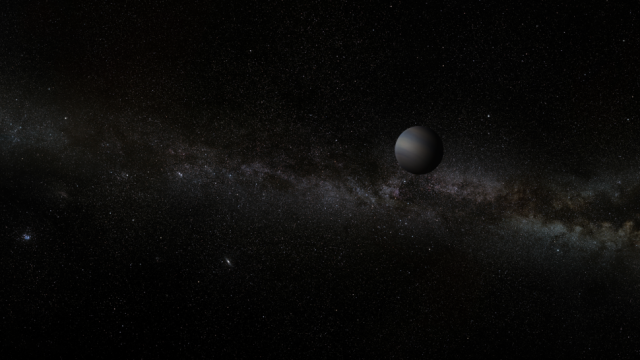Data gathered by NASA’s now-retired Kepler Space Telescope has revealed a small population of free-floating planets near the Galactic Bulge. The new finding raises hope that a pair of upcoming missions will result in further detections of unbound planets, which drift through space separated from their home stars.
The Kepler mission ended in 2018, but its legacy continues to unfold. During its nearly 10 years of service, the famous space telescope managed to detect at least 2,245 exoplanets, with thousands yet to be confirmed. We can now add four new candidate planets to the list, but these aren’t of the typical variety. They’re unbound, meaning they’re not in orbit around any star.
Rogue planets, are they’re informally known, likely formed from a protoplanetary disc around a host star but were then tossed out into interstellar space by the gravitational perturbations of larger planets. These wanderers range in size from Earth-like through to Jupiter-scale behemoths. Fascinatingly, they might be exceptionally abundant, with some scientists estimating trillions of them in the Milky Way. Their true population size remains a mystery, however.
In new research published today in Monthly Notices of the Royal Astronomical Society, a team of astronomers presented their analysis of data gathered during the Kepler K2 mission. The group was led by Iain McDonald, a lecturer in astrophysics at the Open University and a research fellow at the University of Manchester. The paper describes how, from late April to early July 2016, Kepler periodically gazed upon a large cluster of stars located near the Galactic Bulge as it hunted for gravitational microlensing events.
As Einstein famously predicted, foreground objects can warp the light emanating from background stars. This results in the temporary magnification of the incoming light from our perspective, and the effect can last from just a few hours to a few days. Microlensing events are relatively rare, and those produced by rogue planets are even rarer.
As McDonald explained in an email, he and his team performed the study because they wanted to find out how many rogue planets might exist, as past studies tend to vary in terms of estimates.
“Free-floating planets are the ruins of the formation of planetary systems where the orbits of planets and stars were incompatible,” wrote McDonald. “The number of free-floating planets we see tells us how violent the process of making planets normally is.”
Importantly, a special data reduction technique was needed for this research, as Kepler wasn’t designed to detect planets with microlensing events. More common for the space telescope is to find exoplanets using the transit method, in which a passing exoplanet causes a noticeable dimming in its host star.
“Scientists are often challenged to find new uses for old equipment,” said McDonald. “In this case, it involved five years’ work from two people,” namely Radek Poleski, a co-author of the study and an astronomer at the University of Warsaw, and McDonald himself. Poleski’s contribution allowed the team to obtain the best measurements of a star’s brightness from the ailing Kepler telescope, while McDonald’s work resulted in a tailor-made technique for “searching over 12 billion measurements of stars’ brightnesses for events that could be free-floating planets,” he explained.
Looking at the Kepler K2 data, the scientists documented dozens of short-duration microlensing events near the galactic core. Of these, 22 were previously detected during the OGLE and KMTnet ground-based campaigns, but five signatures hadn’t been seen before. Of these five, one turned out to be a bound exoplanet, but the remaining four featured super-short microlensing events consistent with free-floating planets. One of the four candidate signatures was subsequently detected in ground-based data. The microlensing events, lasting for just several hours, suggest the discovery of unbound exoplanets no larger than Earth. These four events have been designated candidate free-floating planets, because astronomers cannot go back and look at them again, as McDonald explained.
“They are too faint to see directly, and unlikely to ever microlens another star on human timescales, so we can’t prove definitively that these are free-floating planets,” he wrote. “Instead, what we have had to do is rule out every other scenario we can think of. We have tried to rule out problems with [Kepler and its instruments], bodies in our solar system like asteroids, pulsating and other kinds of variable stars, and flares on stars with strong magnetic fields. The only likely explanation we were left with is free-floating planets.”
It’s impossible to know what the conditions are like on these presumed rogue exoplanets, but McDonald said they could be “cold, icy wastelands,” and, if similar in size to Earth, their surfaces would “closely resemble bodies in the outer Solar System, like Pluto.”
The new paper suggests the presence of a large population of Earth-sized rogue planets in the Milky Way. It’s becoming clear that free-floating planets are common. McDonald said his team is currently working to come up with a more precise estimate for how many of them might exist.
The new research also shows that free-floating planets can be detected with current telescopes. That said, NASA’s Nancy Grace Roman Space Telescope and ESA’s Euclid mission are poised to discover even more.
“The Roman and Euclid missions are much more powerful telescopes than Kepler and will be much more stable,” McDonald explained. “Plans exist to point these telescopes at the same patch of sky and look for other free-floating planets. Finding these planets with Kepler gives us confidence that this is a good use of the limited time that we will be able to use Roman and Euclid for, and lets us hone how we will perform those observations to make the best detections.”
If rogue planets really are abundant, the aforementioned missions should have no difficulty in finding them. It’s only a matter of time before we know more about these celestial nomads.
More: Warped light reveals smallest rogue planet known to science.
